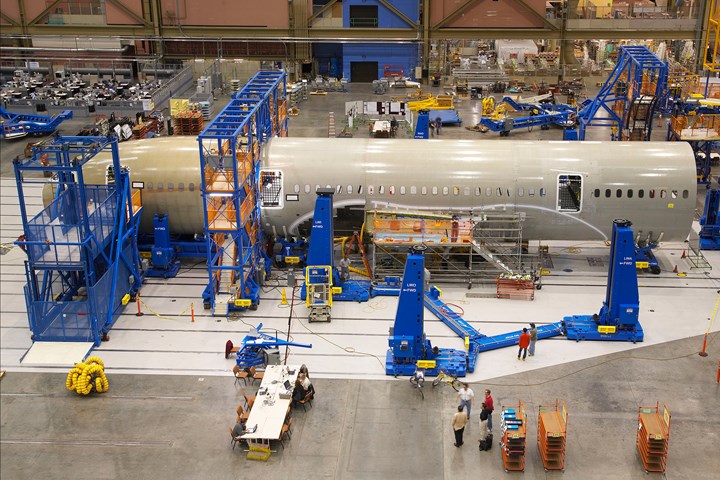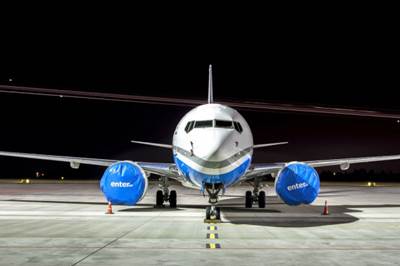Boeing adjusts 2021 787 production downward
Persistent headwinds in international air travel have compelled Boeing to reduced 787 production from six to five per month by mid-2021.

Boeing 787 final assembly line fuselage assembly. Photo Credit: Boeing
Greg Smith, CFO and VP of enterprise operations at Boeing (Chicago, Ill., U.S.), spoke at a Credit Suisse meeting on Dec. 4 and announced that Boeing is reducing 787 production from six aircraft per month to five aircraft per month by mid-2021.
Smith noted that the 90% drop in international air travel in 2020, combined with the late-2020 outbreak surge in the COVID-19 pandemic and feedback from customers, caused Boeing to scale back 787 production: “As a result of that, we’ve made a modest adjustment to the 787 production rate from what we had previously announced [as a] rate of six aircraft per month beginning mid-2021 to a rate of five per month by mid-2021. And as we’re transitioning to that lower rate between now and mid-2021, we’re going to see the effective production rate be below 10 for that period of time.”
Smith also noted that, “While we balance the supply and demand through the near-term impact and the global pandemic, we do remain very confident in the long-term outlook and certainly the health of the 787.” Boeing, he said, has a “large number” of undelivered 787 in inventory that needs to be worked through. Part of this work includes an effort to perform a detailed inspection of each aircraft to assess potential problems discovered earlier this year involving shimming of composite rear fuselage sections.
“The additional time that we’re taking to inspect and ensure that each of our 787s are delivered to the highest quality standards is taking longer than previously anticipated,” he said. “Conducting the comprehensive reviews is absolutely the right thing to do for our customers and the long-term health of the program.”
Boeing had been producing as many as 14 787s a month as recently as 2019, but had planned to reduce that number to 10 a month, even before the pandemic. Boeing’s inventory of undelivered 787s is 56 aircraft, according to data reported by Cirium. Boeing has delivered 53 787s in 2020, through the end of November.
In the short-term, Smith said, Boeing is focused on working with its customers to get the 737 MAX back in service following U.S. and European re-certification in November. He noted that there are 450 737 MAX aircraft grounded, thus the constraint is not Boeing’s ability to deliver the single-aisle aircraft, but to work with customers to return grounded planes to service at a “very strong pace. We are resourced to do that.” Smith also reiterated that Boeing expects to produce 31 737s per month by 2022.
The 777X, Smith said, continues to go through the certification process ahead of its entry into service (EIS). This process, he acknowledged, has been affected by lessons learned from the 737 MAX re-certification. He did not say what Boeing’s estimated EIS date is for the 777X.
Longer term, Smith said Boeing expects domestic routes to recover ahead of international routes and that the company is focusing on liquidity, supply chain health, market conditions and being proactive with its operations. “We’re comfortable about where we are today,” he said. Regarding the prospect new aircraft development, Smith said Boeing has “not lost sight of the future” and is leveraging R&D work done for the NMA (New Mid-sized Aircraft), which Boeing chose not to develop, to help guide decisions about a new aircraft program. “We’ll make the right call when we need to make it,” he said. “This is a portfolio that we feel good about, but have not lost sight of opportunities in the marketplace.”
Related Content
Plant tour: Spirit AeroSystems, Belfast, Northern Ireland, U.K.
Purpose-built facility employs resin transfer infusion (RTI) and assembly technology to manufacture today’s composite A220 wings, and prepares for future new programs and production ramp-ups.
Read MoreInfinite Composites: Type V tanks for space, hydrogen, automotive and more
After a decade of proving its linerless, weight-saving composite tanks with NASA and more than 30 aerospace companies, this CryoSphere pioneer is scaling for growth in commercial space and sustainable transportation on Earth.
Read MoreA new era for ceramic matrix composites
CMC is expanding, with new fiber production in Europe, faster processes and higher temperature materials enabling applications for industry, hypersonics and New Space.
Read MoreCarbon fiber in pressure vessels for hydrogen
The emerging H2 economy drives tank development for aircraft, ships and gas transport.
Read MoreRead Next
FAA rescinds suspension order, approves 737 MAX operations
All airlines under the FAA’s jurisdiction, including those in the U.S., can now resume services. Boeing has further strengthened its safety and quality assurance.
Read MoreFrom the CW Archives: The tale of the thermoplastic cryotank
In 2006, guest columnist Bob Hartunian related the story of his efforts two decades prior, while at McDonnell Douglas, to develop a thermoplastic composite crytank for hydrogen storage. He learned a lot of lessons.
Read MoreComposites end markets: Energy (2024)
Composites are used widely in oil/gas, wind and other renewable energy applications. Despite market challenges, growth potential and innovation for composites continue.
Read More

















.jpg;maxWidth=300;quality=90)








